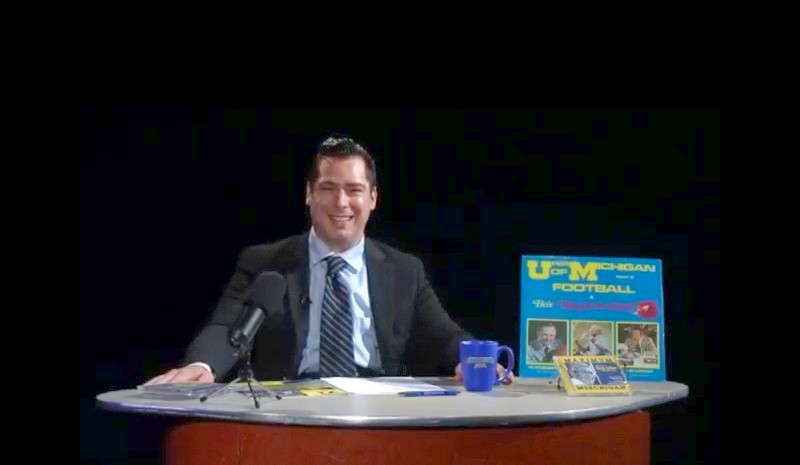Muse Over: Emma McDermott finds inspiration from relationships on “She Likes to Fly” album

For Emma McDermott, people from her past and present provide the ultimate creative inspiration.
The Nashville, Tennessee electro-pop singer-songwriter thoughtfully channels previous relationships and memorable interactions on her reflective debut album, She Likes to Fly.
“I write a lot of my lyrics from my heart … not necessarily as journal entries, but if I’m feeling a certain feeling, and I’m able to put music to it, then it’s almost like being in a musical,” said McDermott, who hails from Ann Arbor and studies commercial voice at Belmont University.
“I do like to write about what I’m feeling, the times that I’ve had, and the people who have come and gone in my life. I write people as muses a little bit, so if I had a relationship in high school, and then I was just reflecting on it during my sophomore year of college, then that’s what fuels the lyrics and fuels the feeling.”
Throughout She Likes to Fly, McDermott chronicles an emotive journey of self-discovery that grooves and glides through life and love. Alongside intimate lyrics, magnetic synth-based instrumentation, and infectious dance-pop hooks, she provides captivating tales that instantly resonate with listeners.
“That’s sort of how it came together, just on its own,” McDermott said. “The songs were written over a span of like two or three years, so it wasn’t like I sat down and said, ‘Oh, I’m gonna write this album about this subject matter.’ It was kind of like a conglomerate sort of entity, and all those songs found their way toward each other to be on the album.”
Out of the "Shadows": Jazz vocalist Olivia Van Goor explores lesser-known songs on her debut EP and returns to Blue LLama

This story originally ran on February 7, 2022. We're featuring it again because Olivia Van Goor will play Blue LLama Jazz Club on July 30.
For her debut EP, When The Shadows Fall, Milford jazz vocalist Olivia Van Goor unearthed and reshaped five hidden gems from the Great American Songbook and beyond.
“None of them are any of the classic standards like ‘Fly Me to the Moon,'" Van Goor said. "I intentionally chose standards that most professional working jazz musicians know, but not all of them. The two that are standards are ‘Willow Weep for Me’ and ‘No Moon at All. ... I did the Detroit Jazz Workshop two years in a row, and the first time I sang ‘Willow Weep for Me,’ and the second time I did ‘No Moon at All.’ I picked my milestone moments with learning the music.”
Those milestone moments also serve as a timeless journey through a spectrum of emotions ranging from hope to heartbreak. Each When The Shadows Fall track waltzes, swings, and bops from one era to the next.
“I was really inspired by Veronica Swift, and she’s one of the best jazz vocalists of the time right now," Van Goor said. "On her last album, she took some musical theater songs that haven’t been taken by any of the legends and turned into standards and did them in that format.
“If you listen to an old recording of ‘Shadow Waltz,’ you’ll notice the style is completely different (from my version). I arranged all of the songs, and that’s my biggest originality to it, except I wrote the lyrics to ‘Hershey Bar.’”
The Olivia Van Goor Quartet will return to Ann Arbor’s Blue LLama Jazz Club on Feb. 18 July 30 and will perform songs from When The Shadows Fall as well as some past and new tunes.
Just Want You to Know Who I Am: Ann Arbor indie-rocker Ceolsige introduces herself to the world on self-titled debut EP

Ceolsige just wants to introduce herself.
“Right now, with my music, all I’m trying to do is just let people know who I am," said Ann Arbor indie-rock singer-songwriter Kelsey Detering, who just released her debut EP under the artist moniker Ceolsige (pronounced see-ole-sidge), the old English variant of her first name.
"Especially, with this EP, I’m not trying to give any specific take on myself or anything. This is a taste of everything about me in one little package. I’m giving people that so they’ll know who I am as an artist. ‘Ceolsige’ is still me, that’s why I chose it. I don’t overthink my identity that much; I just do what feels right.”
Ceolsige eagerly follows her instincts across four honest, mighty tracks that question life, love, and society. The self-titled EP’s introspective lyrics, vigorous instrumentation, and arena-sized arrangements invite listeners to reflect and travel alongside her.
“What comes across a lot of my music right now is uncertainty … because of the age I’m at and time going by. I’m like, ‘OK, what’s gonna happen in my life? Am I gonna meet someone? Am I gonna enjoy things? Are we gonna fix this broken world? Are we going to improve things?” said Detering, a University of Michigan alumna and Ann Arbor School of Rock vocal/piano instructor.
“That gets played up more in people’s minds now, especially because uncertainty in life is heightened everywhere and all the time. I’ve picked up even more on that now.”
In Real Life: Indie rocker Kelly Hoppenjans shares pandemic-era experiences on “Can’t Get the Dark Out”

Kelly Hoppenjans prefers to view love and life through a realistic lens.
The Ann Arbor indie-rock singer-songwriter and guitarist shares a real-life account of pandemic-era relationships, life changes, and personal growth on her introspective new EP, Can’t Get the Dark Out.
“This pandemic has been a really tough time to be alone, and it’s made it difficult to navigate changing relationships, too.," she said. "I wrote ‘Love of My Life (In My Living Room)’ about my frustration with online dating, and a few months after writing it met the love of my life through a dating app.”
Hoppenjans, who relocated from Nashville, Tennessee to pursue a doctorate in musicology at the University of Michigan, said, "By the time I met him, I’d already decided I was leaving town for my doctorate, and I wrote ‘Parallel Lines’ about the irony of meeting someone when I had one foot out the door, wanting to leave town but not him. He moved up here with me, so that worked out in the end.”
On Can’t Get the Dark Out, Hoppenjans dissects past heartbreak, navigates newfound love, and weathers interstate moves across five journal-entry-inspired tracks. The 20-minute EP seamlessly flows through alt-rock and folk-rock sensibilities with forthright lyrics.
“I feel like sometimes when we envision positive things, like love or marriage or children coming to us in the future, we think, ‘That will fix everything,’ like the struggles will evaporate once we achieve those goals. That’s just not how it works,” she said.
“Being in love has brought so much joy to my life, and it’s also one of the hardest things I’ve ever done. It doesn’t fix anything magically … all the baggage we bring with us … it haunts us in our relationships, and we work through it together.”
Hoppenjans will share her Can’t Get the Dark Out experiences and songs during a May 6 EP release show at The Bling Pig with special guests Ani Mari and Clay in the Woods.
Transcontinental Travelogue: Country-pop singer-songwriter Katie Pederson recounts her solo journey on "Limitless"

In November 2019, Katie Pederson embarked on a solo, transcontinental road trip.
The monthlong expedition allowed the pop-country singer-songwriter and pianist to process past sorrows and reconnect with herself before relocating to Tennessee from Michigan.
“When I left Michigan, I knew I was gonna move to Nashville, but I didn’t quite know … so I just left,” said Pederson, who hails from Ann Arbor.
“I wanted to go to the mountains to get some perspective, so I went out to Alberta, Canada, and stopped at hostels along the way in North America. I did a lot of hikes in different areas, read a lot of Mary Oliver’s poetry, and met a lot of really wonderful people.”
Those therapeutic experiences provided the magical inspiration for Pederson’s new sophomore album, Limitless, and helped her explore a sense of renewal within a nature-rich landscape.
Pederson will recount her Limitless journey during an April 24 album release show at The Ark with special guest Grace Theisen, a Kalamazoo blues-Americana singer-songwriter.
Recovery Strategy: Chelsea singer-songwriter Scotty Karate finds catharsis on "Always Honey"

Scotty Karate’s therapeutic album Always Honey chronicles a path to personal growth and recovery.
The Chelsea alt-country singer-songwriter and multi-instrumentalist shares his vulnerable experiences with addiction, loss, and heartbreak on his latest insightful album via Ann Arbor's Ravine Records.
“It’s been some pretty heavy-duty times, and with my whole recovery the last four years," said Karate, aka Fredric Scott Leeman, who works at Washtenaw County’s Community Mental Health. "I’ve reflected a lot on past relationships and things like that."
Karate started reflecting on those relationships and experiences in January 2018 when he received treatment at a local rehabilitation center and resided in transitional housing for 15 months. At the time, he saw several friends get kicked out, then relapse, and later pass away.
“With my own experiences and how they worked out, I had to see this [trauma] … you couldn’t not see this living with these people. It was kinda the point,” Karate said. “Even if it wasn’t that, I felt like I was on this boat, and if you got on this side or that side of the boat, everybody fell off … so you had to stay in the middle of the boat. It’s so tricky, it’s not just kids having fun anymore, none of it is.”
Talk, Talk, Talk: Zach Damon's "Ann Arbor Tonight" puts a local spin on the late-night TV chat format

At age 6, Zach Damon discovered his love of public speaking.
The future Ann Arbor Tonight host-producer was an ambassador for March of Dimes and spoke at different events in the early ‘90s, including the National Athletic Awards at Detroit’s Fox Theatre.
“I remember being in the audience because it was a pre-taped show and seeing the great energy and the great camaraderie of the business in general,” said Damon, who was born with cerebral palsy and grew up in Ann Arbor. “Everyone was so encouraging, and they’d say, ‘Zach, you can do anything you want to do, and if you want to work in media one day, then you can do that.’”
Damon also became inspired watching TV sportscaster Greg Gumbel and author-journalist Mitch Albom serve as hosts of the awards show. In that moment, he found his purpose.
“I remember seeing one of the broadcasters on stage doing his thing, getting the cues during the show, and then presenting," he said. "I remember at one point looking at the stage and saying to myself as a 5 or 6-year-old … I’d really like to be that person … and that’s where I felt most comfortable.”
Damon carried that dream with him throughout his teen years. By his junior year at Ann Arbor’s Pioneer High School, he aspired to host a late-night talk show.
“I was talking to some buddies of mine who were in the film and video club, and I said, ‘It would be really neat to have a late-night show in Ann Arbor and call it Ann Arbor Tonight,” said Damon, who’s inspired by The Tonight Show and Saturday Night Live. “I was sitting on my bed, and they were like, ‘Yeah, whatever, Zach.’ I always have these very big ideas, but I really felt that they were possible if you just put the action toward it.”
Conversation Starter: Chuck Marshall Unites Local Music Community on "Fans With Bands" Podcast

For Chuck Marshall, a regular morning routine inspired a new creative pursuit.
The Ann Arbor live music photographer and Life in Michigan blogger started listening to different podcasts during his daily pandemic lockdown workouts with wife Brenda Sodt Marshall.
“I really wasn’t on the podcast train until the pandemic came," said Marshall, who works in IT at Michigan Medicine. "I started thinking about how I couldn’t go to shows and how it was fine for me to be talking to a band and asking them questions, but wouldn’t it be fun if fans could chime in with questions or be there and listen?
“The pandemic kinda helped with that because we were using Zoom, and I was like, ‘Oh, I could do a Zoom with this person.’ I realized Zoom records separate tracks of audio, so I could clean it up and get it all nice.”
Journal Entries: Cashmere Washington's reflective new collection provides a therapeutic outlet for the Ypsi singer-songwriter

Cashmere Washington’s The Shape of Things to Come serves as a vulnerable, poignant journal for releasing painful feelings, memories, and experiences.
The Ypsilanti indie rocker eloquently tackles the challenges of relationship abuse, childhood trauma, gender, and identity across six insightful, therapeutic tracks on their new EP, which is part of an ongoing series of journaling-like songs that started as ‘therapy homework’ from my therapist to just write six letters to the people who hurt me and I wanted to let go of," said Washington, aka Thomas Dunn, who is also the hip-hop beatmaker guero. "After I wrote the first four in a week, I liked them so much I couldn’t stop writing."
Backed by raw electric guitars, thumping drums, and roaming bass, The Shape of Things to Come is a powerful outlet to show Washington's inner strength and powerful voice while acknowledging and shedding long-term guilt and shame.
All the Pretty Things: Mirror Monster combines electronics and acoustic instruments to soundtrack cathartic personal journeys

Mirror Monster’s latest EP, Pretty Things Made With All Our Love, extracts the hidden emotional beauty from the bleakest of times. The seven-song collection by the Ann Arbor electronic-experimental duo of David Minnix and Michael Skib is a cathartic, reflective journey that thoughtfully processes internal growth amidst a turbulent external landscape.
Mirror Monster’s enchanting folk-electronica odyssey glides through contemplative tracks about personal losses, the swift passage of time, ethereal encounters, and vivid memories.
“In my view, if you can grow as a human being through the act of creating music, even if nobody buys or listens to it, you’ve still gained something incredibly valuable," said Skib, who formed the project with Minnix in 2019 and named it after a Deerhoof track. "In that sense, I feel a tremendous amount of this success from this project.”


































